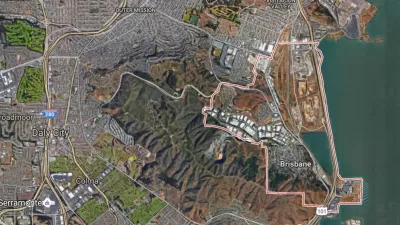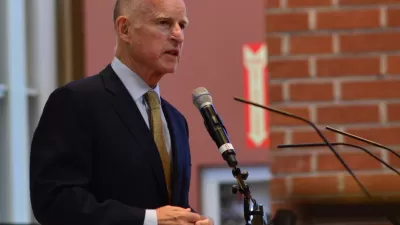Emissions from electricity generation are decreasing while those from transportation are increasing. If communities don't increase housing density to change travel patterns, it will only get worse, but the challenges may be insurmountable.

"While emissions from electrical plants fell in 2015, driven down partly by the rapid growth of large solar facilities, the amount of greenhouse gases spewed by cars and planes rose," reported David R. Baker for the San Francisco Chronicle in June on the California Greenhouse Gas Emission Inventory - 2017 Edition.
Illustrating why it is so difficult to reduce those transportation emissions, Liam Dillon reported for the Los Angeles Times on March 6 on the necessity to reduce driving in Southern California to meet climate goals, and the resistance by local communities to making the necessary land use changes that will change travel patterns.
“You can’t be pro-environment and anti-housing,” said Marlon Boarnet, chair of the Department of Urban Planning and Spatial Analysis at USC’s Price School of Public Policy, who has advised state climate regulators on land-use issues. “You can’t be anti-sprawl and anti-housing. This is something that has not been very well understood.”
The Southern California Association of Governments (SCAG), the metropolitan planning organization (MPO) for Los Angeles, Imperial, Orange, Riverside, San Bernardino and Ventura counties, has to prepare a regional transportation plan and sustainable communities strategy that shows how it will reduce greenhouse gas emissions resulting from transportation, as do the state's other 17 MPOs, according to SB 375, the Sustainable Communities and Climate Protection Act of 2008.
But those efforts haven’t been enough. In a series of reports over the last year, climate regulators have said California needed to reduce driving by an additional 15% over what regional governments have already planned to meet the 2030 greenhouse gas targets. That means even more closely packed housing than previously anticipated will be needed.
Hasan Ikhrata, SCAG's executive director, believes the new push to reduce driving is too difficult to achieve. “We’re going to do our best, but I think it’s too ambitious, to be honest with you,” Ikhrata said.
Of course, resistance to increased density is not restricted to Southern California. Reporting on July 28 from the small Bay Area city of Brisbane, population 4,700, just south of San Francisco in San Mateo County, Dillon describes the opposition to a development proposal located adjacent to a commuter rail station that could create a substantial dent in the region's housing crisis by providing 4,400 homes on 660 acres of vacant brownfield. But it's more than just local opposition to increased density that makes smart growth difficult in the Golden State.
The project, Brisbane Baylands, reveals how few incentives local governments have to accept large developments — even as the state is pushing to lower housing costs and funnel growth toward existing cities and nearby mass transit to combat climate change.
Under California’s tax system, Brisbane also earns more money if it rejects the current plan in favor of potential alternatives with more hotel rooms and space for businesses — but no homes.
While the "anti-development fervor" that has gripped Brisbane is the main focus of Dillon's piece, he also describes the challenges posed by the regulatory and economic framework that make smart growth so challenging in the state's coastal regions.
Hat tip to David McCoard.
FULL STORY: A Bay Area developer wants to build 4,400 sorely needed homes. Here's why it won't happen

Alabama: Trump Terminates Settlements for Black Communities Harmed By Raw Sewage
Trump deemed the landmark civil rights agreement “illegal DEI and environmental justice policy.”

Study: Maui’s Plan to Convert Vacation Rentals to Long-Term Housing Could Cause Nearly $1 Billion Economic Loss
The plan would reduce visitor accommodation by 25% resulting in 1,900 jobs lost.

Planetizen Federal Action Tracker
A weekly monitor of how Trump’s orders and actions are impacting planners and planning in America.

Wind Energy on the Rise Despite Federal Policy Reversal
The Trump administration is revoking federal support for renewable energy, but demand for new projects continues unabated.

Passengers Flock to Caltrain After Electrification
The new electric trains are running faster and more reliably, leading to strong ridership growth on the Bay Area rail system.

Texas Churches Rally Behind ‘Yes in God’s Back Yard’ Legislation
Religious leaders want the state to reduce zoning regulations to streamline leasing church-owned land to housing developers.
Urban Design for Planners 1: Software Tools
This six-course series explores essential urban design concepts using open source software and equips planners with the tools they need to participate fully in the urban design process.
Planning for Universal Design
Learn the tools for implementing Universal Design in planning regulations.
Caltrans
Smith Gee Studio
Institute for Housing and Urban Development Studies (IHS)
City of Grandview
Harvard GSD Executive Education
Toledo-Lucas County Plan Commissions
Salt Lake City
NYU Wagner Graduate School of Public Service





























